End-to-End Innovations
Integrated lines, flexible machines, and high-barrier materials enhance packaging options.
Concerns about efficiency and sustainability are inspiring improvements to equipment for all parts of the packaging line. Many packaging innovations and portents of future trends were on display at the most recent Pack Expo International, which was held in Chicago, Illinois, in November 2008.

Hallie Forcinio
Tablet-filling and labeling lines
Uhlmann Pac-Systeme, long known for its blister-packaging equipment, launched a fully integrated tablet-filling line at the show. The line is the company's first foray outside blister packaging equipment and its first product introduction outside Germany ("Integrated Bottle Center," Uhlmann Pac-Systeme, Laupheim, Germany).
The turnkey, modular line integrates equipment from several suppliers to fill as many as 240 bottles/min. The line's hygienic design and automated changeover reduce downtime. Designed to comply with stringent European limits, the line generates noise levels of less than 74 dB, even at top speed. Bottles ranging in diameter from 35 to 76 mm and as tall as 193 mm pass through an unscrambler and receive a two-dimensional code, which is checked by a vision system for correctness and readability. Code data also are captured and stored to enable future tracking and tracing. When the bottle arrives at the desiccant dispenser, another camera checks the code. If it's not accurate, no desiccant is dispensed, and an integrated shift register ensures the bottle is not filled or capped.

TETRA IMAGES/GETTY IMAGES
The next step is the filler, which maintains positive control of tablets. After filling, a metal detector checks for contamination before a rotary chuck capper applies the cap. The capped container than passes below an induction sealer. Just before the exit, another camera checks the bottle code once again. Three lanes at the exit transport good containers and shunt aside rejects and samples. Line operation and changeover is controlled from the operator interface. Changeover between bottle sizes requires no physical adjustments and takes only 20 min.
Another turnkey line supports ePedigree serialization and track-and-trace initiatives. Incorporating equipment from several companies, the line consists of a pressure-sensitive labeler, shrink bundler, several vision systems, and a case packer and palletizer. The labeler applies serialized, two-dimensional barcodes or radio-frequency identification (RFID) labels. The vision system captures the serialized codes and makes the data available to ePedigree software through an Ethernet connection. Serialized containers are shrink bundled, and a print-and-apply labeler applies another label, which may be RFID-equipped. This label also is checked by a vision system. Shrink-bundled products are then loaded into cases, which are labeled by another unit. A third vision system checks these labels (Integrated packaging line for product serialization, NJM–CLI, Lebanon, NH).
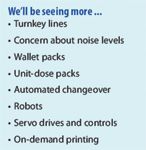
We will be seeing more ...
Primary packaging
Innovations related to blister packs, a common pharmaceutical container, were also in evidence at the show. One line automates the assembly of a paperboard wallet pack with a dual sliding mechanism that keeps the medication and information leaflet together. Pulling the leaflet carrier causes the blister card to slide out the opposite side, thus providing access to the tablets. Prefolded patient information booklets can contain as many as 24 pages. The 17-m machine handles single or double blister formats at rates as high as 150 packs/min. A special feeding-wheel technology for fast pick-and-place operation, combined with a transverse product infeed chain, minimizes format changeover time ("Burgopak" wallet pack, Burgopak, London and Burgopak packaging line, Sigpack Systems, Beringen, Switzerland).
A small unit for filling solid dosage forms into bottles counts pills at as many as 300 bottles/min. The machine reportedly provides better count accuracy than electronic counters or slat fillers and can be equipped with a color inspection system. Other features include integrated dust management and reject tracking. The machine can be disassembled in 20 min for cleaning and requires few change parts ("ACT9000" bottle filler, Aylward, New Bern, NC).

Uhlmann's completely integrated, turnkey bottle-filling line.
A new inserter cuts cotton coil with a guillotine blade, thus eliminating strands that could get caught in the capper, as well as fiber residue that complicates cleaning. The compact, portable unit can be configured with single or dual heads and offers speeds as high as 60 bottles/min. Its features include a programmable logic control, touch-screen operator interface, adjustable cutting head for lengths of 2–7 in., and stepper motor-driven rollers. A motorized height-adjustable stand enables the unit to be moved easily from line to line ("CF-1" automatic cotton inserter, ABOX Automation, Wharton, NJ).
An upgraded dispenser slices desiccant or oxygen-absorber pouches from a roll and drops them into containers at rates as high as 300 bottles/min. An open exit chute reduces the chance of jams, and an angled feed ensures accurate pouch placement. A touch-screen operator interface and 1-min knife replacement expedite changeover. A remote access feature supports diagnostics to minimize service time and costs ("AZCO VIP-100 Sur-Pak" pouch dispenser, AZCO, Fairfield, NJ).
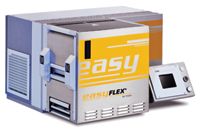
Hapa on-line ultraviolet printer reduces waste and inventory by printing blister foil on demand.
A polypropylene utensil, designed to be handled with one hand, breaks open along a score line to release a single dose of liquid or dry product. Available in spoon, fork, stirrer, and brush configurations, the package consists of an injection-molded shell and printed foil-laminate lidstock. A custom machine fills the utensil's reservoir with 4–20 mL of product and seals the lidstock in place ("Snapsil" utensil, Snapsil, Birtinya, Australia; "Optima Snapsil 400" fill–seal machine, Optima Group Consumer, Schwäbisch Hall, Germany).
Another one-handed, single-dose dispensing design combines a scored semirigid bottom web with a flexible top web in a four-side-sealed construction. Folding the edges of the pouch together breaks the score and dispenses the liquid or semiliquid product. The proprietary bottom web consists of polystyrene–ethylene vinyl alcohol–polyethylene (PE) and flexes 90° (bottom barrier web for butterfly sachet, Alcan Packaging, Chicago, IL).

Butterfly sachet with a proprietary semirigid bottom web folds to dispense a single dose of liquid or semiliquid product.
A special vertical form–fill–seal machine combines top and bottom barrier webs and fills 150 packs/min. Four standard pack sizes hold 1–25 mL and measure 40 × 30, 40 × 80, 45 × 80, or 60 × 100 mm ("Easysnap3" vertical form–fill–seal machine, Easypack Solutions, Brantford, Ontario, Canada). The first machine is destined for Knowlton Development (Knowlton, Quebec, Canada), a large liquid personal-care contract packager.
End-of-line equipment
Suppliers of end-of-the-line equipment such as case packers and palletizers are building greater flexibility into their units. One new case packer handles vertical and horizontal pack patterns or a combination of both with the push of a button. The two-robot unit suits operations that pack multiple products or use multiple-pack orientations that otherwise would require more than one machine or complex changeovers. It also offers tape or hot-melt sealing. The first robot collates product in the proper pack pattern, and a second robot picks and places the collation in a case. Simultaneous case erecting, accumulation, loading, and sealing maximize throughput ("HVCP" case packer, Schneider Packaging Equipment, Brewerton, NY).

Burgopak difficult-to-counterfeit design combines consumer convenience with tamper evidence.
A new machine palletizes corrugated cases and loads cartons into plastic crates and palletizes them. Central to the design is a four-axis gripper–transfer mechanism. Features include a compact footprint, servo-driven action, and easy management of different case infeed heights ("P9" palletizer, Cermex, Norcross, GA).
Doing more with less also is a popular theme with end-of-the line equipment. A collating system arranges containers in an alternating pattern to create a tight bundle. The arrangement fits more product into the same space. Potential benefits include material savings, waste reduction, and increased efficiency (single-lane in-double-lane discharge container-handling system, Morrison Container Handling Solutions, Glenwood, IL).
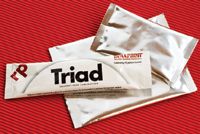
Rollprint foil lamination for blowâfillâseal overwrap applications addresses demands for solvent-free structures.
Labeling, printing, and coding
Two standouts among the many coding, printing, and labeling machines on display at Pack Expo included a syringe labeler and a flexo printer that prints blister foil on demand. The syringe labeler applies various pressure-sensitive label substrates to filled or unfilled syringes at a rate of 360/min. The machine loads syringes from an infeed star wheel onto a roller chain conveyor. A motion-controlled labeling head then applies the label, which is wrapped around the syringe as it passes under the independently driven wrap unit. Digital position indicators on all major adjustments expedite changeover from one syringe size to another. A vision inspection system is optional ("Harland Syringe Master," Harland America, Delran, NJ).
On-demand printing of blister foil reduces inventory and obsolescence issues associated with preprinted rollstock, cuts waste, speeds changeover, and minimizes downtime. Capable of running on either intermittent or continuous-motion blister packaging machines, the ultraviolet flexo printer prints in one color, accepts any index length, and handles web widths as great as 260 mm. A cartridge-based ink system simplifies color changes by eliminating the need to remove the ink fountain, as well as purging and cleaning activities ("EasyFlex" printer, Hapa, Zurich, Switzerland).
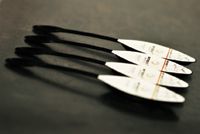
Snapsil's single-serving dispenser, available on the market in Australia, doubles as a utensil.
A carton coder that prints either crash-lock cartons or blister cards applies batch or production codes, expiration or sell-by dates, logos, and barcodes at a rate of 262 ft/min. Servo drives help maintain precise registration and support operation in intermittent and continuous motion. In addition, the system is available with thermal-transfer or hot-foil printing technology, as well as multiple print heads. Changeover to a new carton size is performed without tools or changing parts and takes about 1 min. The machine stops when it senses a double feed, thereby minimizing chances that an unprinted or double-printed carton will be shipped. Options include barcode scanner–verifiers and vision inspection ("ACF-400" carton coder, Norwood Marking Systems–Allen Coding Systems, Downers Grove, IL).
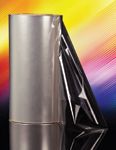
Toray's metallized polyethylene terephthalate offers a light, high-barrier alternative to foil laminations.
Materials
Pack Expo International also featured several materials of interest to pharmaceutical packagers. A new family of high-barrier metallized polyethylene terephthalate (PET) films serves as a low-cost, lightweight alternative to foil laminations. A 36-gauge metallized PET can replace a 48-gauge foil lamination, which could be expensive and complex. The metallized film bolsters source-reduction efforts by eliminating the need for a sealant layer. Resistant to delamination and compatible with hard-to-hold products, the thin, multilayer films offer oxygen-transmission rates ranging from < 0.01 to 0.15 cm3/100 in.2/day and water-vapor transmission rates ranging from 0.03 to 0.15 g/100 in.2/day ("LumLife MK" PET film, Toray Plastics America, North Kingstown, RI).
Another potential foil replacement is a clear film that offers a strong barrier to oxygen and moisture. The product combines an polychlorotrifluoroethylene (PCTFE) fluoropolymer layer and a polyvinylidene chloride (PVDC) coating. The four-layer polyvinyl chloride (PVC)–PVDC–PCTFE–PVC structure is designed for the most sensitive pharmaceuticals and nutraceuticals. Because PVC is the contact layer, the film does not require special tooling on form–fill–seal equipment. Also available in an opaque version, the film exhibits excellent lay-flat characteristics ("Pentapharm kpMax" films, Klöckner Pentaplast Group, Gordonsville, VA).
A new solvent-free foil lamination designed especially for pharmaceutical overwrap applications is an extrusion-coated 48-gauge PET–low-density polyethylene–35-gauge foil–metallocene PE structure. Despite a significantly thinner sealant layer than competing materials, the metallocene PE forms stronger weld seals at speeds higher than 100 ft/min. Typical applications include secondary packaging for blow–fill–seal unit-dose containers for inhalation therapy or diagnostic kits. Reverse- or surface-printed white or natural foil structure can be supplied in rollstock form or as premade pouches or die-cut lids ("Triad" foil lamination, Rollprint Packaging Products, Addison, IL).
Hallie Forcinio is Pharmaceutical Technology's Packaging Forum editor, 4708 Morningside Drive, Cleveland, OH 44109, tel. 216.351.5824, fax 216.351.5684, editorhal@cs.com

Drug Solutions Podcast: A Closer Look at mRNA in Oncology and Vaccines
April 30th 2024In this episode fo the Drug Solutions Podcast, etherna’s vice-president of Technology and Innovation, Stefaan De Koker, discusses the merits and challenges of using mRNA as the foundation for therapeutics in oncology as well as for vaccines.
Pharmaceutical Tariffs Are Imminent: How Industry is Bracing for Impact
April 16th 2025On April 14, 2025, the Trump Administration launched a national security-driven investigation into pharmaceuticals, a move that will likely result in tariffs being placed on pharmaceutical drugs, ingredients, and other components that are imported from outside of the United States.